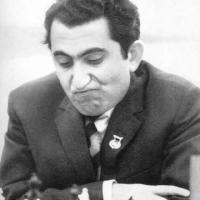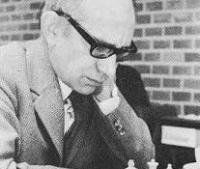
The Tiger
Early Years
Tigran Petrosian was born to Armenian parents on the 17th of June, 1929 in Tiflis, Georgia, which was then a member of the Soviet Union. As a young boy, Petrosian was an excellent student and enjoyed studying, as did his brother Hmayak and sister Vartoosh. He learned to play chess at the age of 8, though his illiterate father Vartan encouraged him to continue studying, as he thought chess was unlikely to bring his son any financial success. Petrosian was orphaned during World War II and was forced to sweep streets to earn a living. It was about this time that his hearing began to deteriorate, a problem that afflicted him throughout his life.
In a 1969 interview with Time Magazine, he recalled:
I started sweeping streets in the middle of the winter and it was horrible. Of course there were no machines then, so we had to do everything by hand. Some of the older men helped me out. I was a weak boy. And I was ashamed of being a street sweeper—that's natural, I suppose. It wasn't so bad in the early morning when the streets were empty, but when it got light and the crowds came out I really hated it. I got sick and missed a year in school. We had a babushka, a sister of my father, and she really saved me. She gave me bread to eat when I was sick and hungry. That's when this trouble with my hearing started. I don't remember how it all happened. Things aren't very clear from that time.
World Champion
His results in the triennial Candidates Tournament, held to determine the challenger to the world champion, showed a steady improvement: fifth at Zürich in 1953, equal third at Amsterdam in 1956, third in Yugoslavia in 1959, and first at Curacao in 1962. In 1963 he defeated Mikhail Botvinnik 12.5–9.5 to become world chess champion. His patient, defensive style frustrated Botvinnik, who only needed to make one risky move for Petrosian to punish him. Petrosian is the only player to go through the Interzonal and the Candidates process undefeated on the way to the world championship match.
Petrosian defended his title in 1966, defeating Boris Spassky 12.5–11.5, the first World Champion to win a title match while champion since Alekhine beat Bogoljubov in 1934.
In 1968, he was granted an M.Phil. from Yerevan University for his thesis, "Chess Logic." In 1969 Spassky got his revenge, winning by 12.5–10.5 and taking the title.
He won four Soviet Championships (1959, 1961, 1969, and 1975).
Contributions to Chess
Petrosian introduced the exchange sacrifice for the sake of 'quality of position', where the time factor, which is so important in the play of Alekhine and Tal, plays hardly any role. Even today, very few players can operate confidently at the board with such abstract concepts. Before Petrosian no one had studied this. By sacrificing the exchange 'just like that', for certain long-term advantages, in positions with disrupted material balance, he discovered latent resources that few were capable of seeing and properly evaluating.
Petrosian was an expert against the King's Indian Defense, and he often played what is now known as the Petrosian System: 1. d4 Nf6 2. c4 g6 3.Nc3 Bg7 4e4 d6 5.Nf3 O-O 6.Be2 e5 7 d5 this variation closes the center early on in the game. One of the tactical ideas for White is to play Bg5, pinning Black's knight to his queen. Black can respond by either moving his queen or by playing ...h6, though the latter move weakens Black's kingside pawn structure. Two of Black's responses to the Petrosian variation were developed by grandmasters Paul Keres and Leonid Stein. The Keres Variation arises after 7 ... Nbd7 8.Bg5 h6 9.Bh4 g5 10. Bg3 Nh5 11.h4, and the Stein Variation begins an immediate queenside offensive with 7 ... a5.
The Queen's Indian Defense also has a variation developed by Petrosian: 1.d4 Nf6 2.c4 e6 3.Nf3 b6 4.a3, with the idea of preventing ... Bb4+. This system received much attention in 1980 when it was used by the young Garry Kasparov to defeat several grandmasters. Today the Petrosian Variation is still considered the most pressing variation, with the greatest score in Master games. A common response for black is 4. ... c6, with the idea of eventually pushing forward with ... d5.
Other Petrosian variations can be found in the Grünfeld Defense after 1.d4 Nf6 2.c4 g6 3.Nc3 d5 4.Nf3 Bg7 5.Bg5, and the French Defense after 1.e4 e6 2.d4 d5 3.Nc3 Bb4 4.e5 Qd7. Some authorities refer to a variation of the Caro-Kann defense with his name, along with former world champion Vassily Smyslov: the Petrosian–Smyslov variation, 1. e4 c6 2. d4 d5 3.Nc3 dxe4 4.Nxe4 Nd7.
In the Words of World Champions
The depth of Tigran’s approach to chess is the direct consequence of his clear mind and his rare insight into general aspects of chess, into subtleties of chess tactics and strategy. Petrosian performed a special kind of art in creating harmonious positions that were full of life, where the apparent absence of superficial dynamism was compensated by enormous inner energy. Every subtle change in the position was always taken into consideration in the context of a complex strategy that was not obvious to his opponents. – Garry Kasparov
Careful study of Petrosian's games is required to form a clear impression of him. He was, so to speak, a very "secretive" player. We can call Petrosian the first defender with a capital D. He was the first person to demonstrate that it is possible to defend virtually every position. Petrosian contributed a defensive element to chess - an element that is being developed more and more today. He showed that chess contains an enormous number of resources, including defensive ones. - Vladimir Kramnik
If we look in chess history for a "double" of Petrosian, we arrive at Capablanca. Petrosian is not a tiger that pounces on its prey, but rather a python, that smothers its victim, or a crocodile, waiting for hours for a convenient moment to land a decisive blow. Petrosian is an outstanding strategist. If he should begin to combine a little, he will be impossible to play against. - Max Euwe
Among all our grandmasters Petrosian possesses the most distinctive and original talent: he places his pieces so astutely, that all attacks on them prove very difficult. This is a subtle and rare style, to which it is hard to adapt. - Mikhail Botvinnik
Petrosian, of course, was a phenomenal chess talent; he played so deeply and interestingly, that he sometimes found ideas for his opponents that never even entered their heads. Petrosian had Capablanca's technique and Schechter’s sense of danger. - Mikhail Tal
and in his own Words
A strong player knows all the rules and laws of the game. A talented player knows everything that a strong player knows, but he also sees exceptions to the rules. But major chess talents (we call them geniuses) gradually transform these exceptions into new rules. And so on ad infinitum, since chess is inexhaustible. - Tigran Petrosian
Here are two further combinations of his to enjoy:






